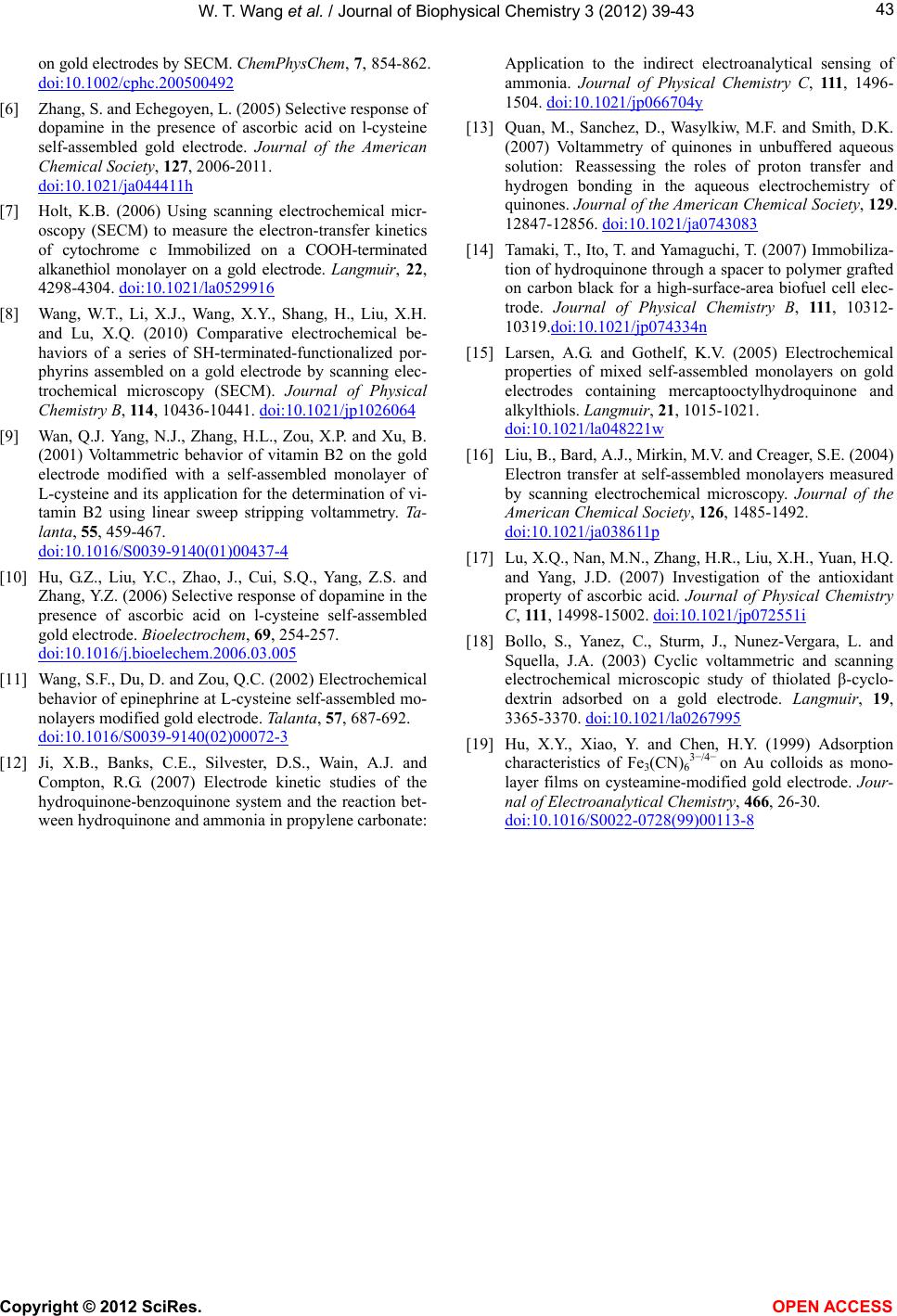
W . T. W ang et al. / Journal of Bioph ysical Ch emistry 3 (2012) 39-43 43
on gold electrodes by SECM. ChemPhysChem, 7, 854-862.
doi:10.1002/cphc.200500492
[6] Zhang, S. and Echegoyen, L. (2005) Selective response of
dopamine in the presence of ascorbic acid on l-cysteine
self-assembled gold electrode. Journal of the American
Chemical Society, 127, 2006-2011.
doi:10.1021/ja044411h
[7] Holt, K.B. (2006) Using scanning electrochemical micr-
oscopy (SECM) to measure the electron-transfer kinetics
of cytochrome c Immobilized on a COOH-terminated
alkanethiol monolayer on a gold electrode. Langmuir , 22,
4298-4304. doi:10.1021/la0529916
[8] Wang, W.T., Li, X.J., Wang, X.Y., Shang, H., Liu, X.H.
and Lu, X.Q. (2010) Comparative electrochemical be-
haviors of a series of SH-terminated-functionalized por-
phyrins assembled on a gold electrode by scanning elec-
trochemical microscopy (SECM). Journal of Physical
Chemistry B, 114, 10436-10441. doi:10.1021/jp1026064
[9] Wan, Q.J. Yang, N.J., Zhang, H.L., Zou, X.P. and Xu, B.
(2001) Voltammetric behavior of vitamin B2 on the gold
electrode modified with a self-assembled monolayer of
L-cysteine and its application for the determination of vi-
tamin B2 using linear sweep stripping voltammetry. Ta-
lanta, 55, 459-467.
doi:10.1016/S0039-9140(01)00437-4
[10] Hu, G.Z., Liu, Y.C., Zhao, J., Cui, S.Q., Yang, Z.S. and
Zhang, Y.Z. (2006) Selective response of dopamine in the
presence of ascorbic acid on l-cysteine self-assembled
gold electrode. Bioelectrochem, 69, 254-257.
doi:10.1016/j.bioelechem.2006.03.005
[11] Wang, S.F., Du, D. and Zou, Q.C. (2002) Electrochemical
behavior of epinephrine at L-cysteine self-assembled mo-
nolayers modified gold electrode. Talanta, 57, 687-692.
doi:10.1016/S0039-9140(02)00072-3
[12] Ji, X.B., Banks, C.E., Silvester, D.S., Wain, A.J. and
Compton, R.G. (2007) Electrode kinetic studies of the
hydroquinone-benzoquinone system and the reaction bet-
ween hydroquinone and ammonia in propylene carbonate:
Application to the indirect electroanalytical sensing of
ammonia. Journal of Physical Chemistry C, 111 , 1496-
1504. doi:10.1021/jp066704y
[13] Quan, M., Sanchez, D., Wasylkiw, M.F. and Smith, D.K.
(2007) Voltammetry of quinones in unbuffered aqueous
solution: Reassessing the roles of proton transfer and
hydrogen bonding in the aqueous electrochemistry of
quinones. Journal of the American Chemical Society, 129.
12847-12856. doi:10.1021/ja0743083
[14] Tamaki, T., Ito, T. and Yamaguchi, T. (2007) Immobiliza-
tion of hydroquinone through a spacer to polymer grafted
on carbon black for a high-surface-area biofuel cell elec-
trode. Journal of Physical Chemistry B, 111, 10312-
10319.doi:10.1021/jp074334n
[15] Larsen, A.G. and Gothelf, K.V. (2005) Electrochemical
properties of mixed self-assembled monolayers on gold
electrodes containing mercaptooctylhydroquinone and
alkylthiols. Langmuir, 21, 1015-1021.
doi:10.1021/la048221w
[16] Liu, B., Bard, A.J., Mirkin, M.V. and Creager, S.E. (2004)
Electron transfer at self-assembled monolayers measured
by scanning electrochemical microscopy. Journal of the
American Chemical Society, 126, 1485-1492.
doi:10.1021/ja038611p
[17] Lu, X.Q., Nan, M.N., Zhang, H.R., Liu, X.H., Yuan, H.Q.
and Yang, J.D. (2007) Investigation of the antioxidant
property of ascorbic acid. Journal of Physical Chemistry
C, 111, 14998-15002. doi:10.1021/jp072551i
[18] Bollo, S., Yanez, C., Sturm, J., Nunez-Vergara, L. and
Squella, J.A. (2003) Cyclic voltammetric and scanning
electrochemical microscopic study of thiolated β-cyclo-
dextrin adsorbed on a gold electrode. Langmuir, 19,
3365-3370. doi:10.1021/la0267995
[19] Hu, X.Y., Xiao, Y. and Chen, H.Y. (1999) Adsorption
characteristics of Fe3(CN)6
3−/4− on Au colloids as mono-
layer films on cysteamine-modified gold electrode. Jour-
nal of Electroanalytical Chemistry, 466, 26-30.
doi:10.1016/S0022-0728(99)00113-8
Copyright © 2012 SciRes. OPEN ACCESS